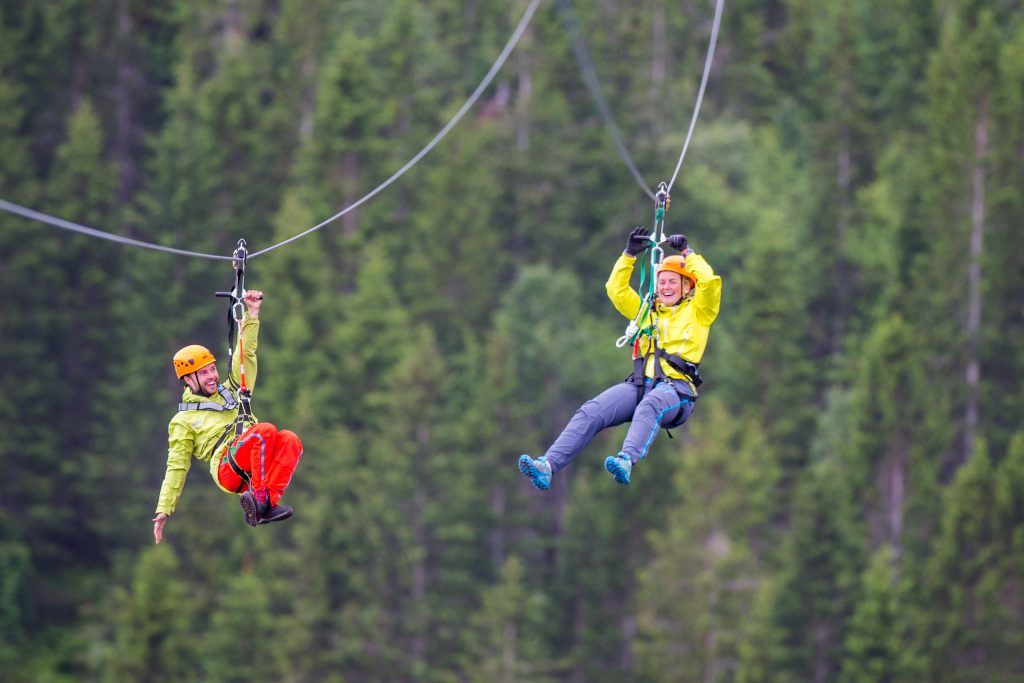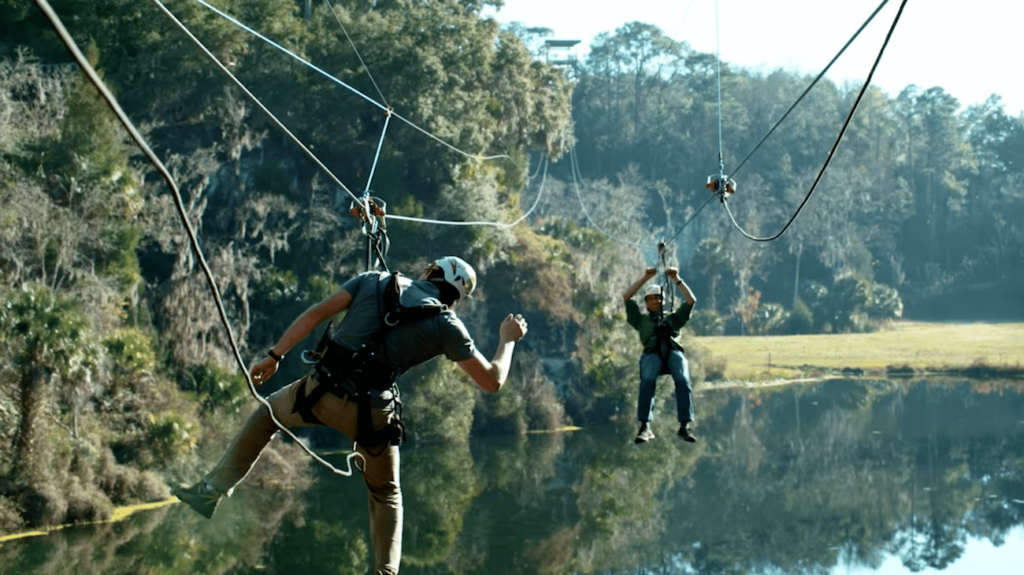There are two main categories of zip line brakes: active and passive. The type of brake you choose will dramatically affect your business’s risk management and the life span of your guests’ zip line experience. Active zip line brakes depend on human intervention to initiate the braking process. Passive zip line brakes automatically activate without the rider or a guide doing anything. While active brakes may give riders and staff more participation in the experience, they may also introduce additional risk.

Active Braking
The most common types of active zip line brakes are leather gloves and brake pads. Participants must intentionally press a glove or brake pad against a zip line cable in order to slow down. Active brakes can substantially increase the risk of injury to participants for several reasons. It is easy for participants to get lost in the excitement and adrenaline of the moment and forget braking instructions. Moreover, active brakes force the rider to put their hands and limbs close to fast moving zip line components. Proximity alone increases the risk that a participant will either get a friction burn on an exposed piece of skin or injure their hand by getting it caught in the rider trolley. These injuries are among the least severe injuries possible when dealing with active brakes. The worst possible injuries associated with active brakes are life-threatening.
When zip line operations use active braking methods, inexperienced and overwhelmed riders have the highest risk for injuries. Some participants might become overwhelmed because they are not ready for the extreme heights and speeds of zip lining. In the worst-case scenario, riders provide no braking force and arrive full speed into the termination structure, creating the possibility of severe injury or death. Increased injury risk is only one problem with active braking.
What happens if the riders choose to brake too early or too aggressively? The answer is that they fail to make it to the platform and the entire group has to wait for them to haul themselves to the end of the line or be retrieved by a staff member. Premature braking is a detriment to the efficiency of your zip line operation and the overall experience. The more happy customers you can get through your zip line course, the higher your potential revenue. Even 30 seconds of downtime per customer can severely reduce the efficiency of your zip line facility. Active braking does not provide an immense amount of control over the throughput of your zip line. If you’re interested in increasing the efficiency of your zip line operation you should read this article about Head Rush Technologies’ solution to the problem.
Active brakes have one last misgiving. They increase wear and tear on crucial zip line equipment. Active brakes rely on friction, and there is no way to get around it. Friction is the fundamental component that makes active brakes work. This very friction is what increases the amount of wear on the active brake itself. Increased wear means that you’re going to have to continuously replace gloves and brake pads. It also means more downtime while your cable and other components are being replaced. At first active braking might look like it costs less, but it may end up costing you more in the long run.

Passive Braking
There are many different types of passive braking. The most commonly used passive brakes are magnetic brakes, gravity brakes, and spring brakes. Passive brakes take the responsibility of braking away from the rider. Passive braking methods will activate even if the participant suffers a breakdown mid zip and is unable to stop themselves. This aspect of risk management alone makes passive brakes superior to active brakes. There are many zip line brakes that fall into the passive brake category, but how do they compare?
Magnetic Brakes

Head Rush Technologies’ zipSTOP Zip Line Brake is in its own tier of passive zip line brakes. The zipSTOP uses eddy current magnetic braking technology to eliminate the need for sacrificial braking components. That means there are no brake pads or any internal braking components whatsoever that rely on friction. The result is that the zipSTOP has less maintenance because there are no components of the braking core designed to wear out or fail. The magnetic technology does more than decrease maintenance and increase product longevity though.
The eddy current magnetic braking technology in the zipSTOP provides consistently smooth braking experiences for participants by self-regulating braking resistance for each individual. A 33 lb kid and a 330 lb football player will both experience the same comfortable deceleration. Other zip line brakes do not have the benefit of self-regulating braking resistance. Without the automatic regulation of braking resistance found in the zipSTOP, the 33 lb kid will have a harsher jolt on impact compared to heavier riders. Magnetic braking allows zip line operations to provide the same high-quality zip line experience to every participant regardless of weight.
In addition to the benefits of magnetic braking, the zipSTOP is incredible for improving throughput. The zipSTOP automatically resets after every use. Automatic reset means less downtime waiting for the guide to reset the brake for the next rider. Automatic reset also eliminates the chance that the guide will forget to reset the brake at all. The throughput efficiency of the zipSTOP is enhanced when it is combined with other Head Rush zip line accessories. The brake trolley in the zipSTOP zip line brake system can be outfitted with a catch mechanism that pairs with the Head Rush LightSpeed Trolleys to eliminate rider rollback. The LightSpeed EZ Clip, Micro, and Impact Trolleys and the brake trolley latch together during the braking process to make rider retrieval quick and painless. Less downtime between riders allows you to get more customers through your course every day and increases your total potential revenue. If you’re interested in increasing throughput on your zip line, you should take a look at this one easy trick to double the efficiency of your zip line.
The decreased maintenance, smooth braking experience and the increased throughput of the zipSTOP make it a truly unique zip line brake. You won’t be able to find a similar zip line brake anywhere that provides the same features and benefits. The zipSTOP is the premiere zip line brake of choice for zip line operators.
Gravity Brakes

A gravity brake is essentially the absence of a zip line brake. Gravity brakes are zip lines designed so that the rider will not be able to reach the end. Usually, zip lines that use gravity brakes have a significant amount of slack so the end of the cable is uphill. The uphill portion of the zip line slows the rider until they change directions. Then they boomerang back and forth until they come to a stop at the sagging low point in the line.
While gravity is a constant force and always reliable, the main drawback of gravity brakes is their low throughput. It takes time for a participant to ricochet back and forth enough to come to a stop. This rolling back and forth to slow down is the least appealing part of the zip line. The time it takes waiting for a gravity brake to slow a participant doesn’t add value for the customer. That time would be better spent sending another rider down the line and would allow the whole group to spend less time waiting and more time zipping.
The other frustrating shortcoming of gravity brakes for zip line owners is the inefficient use of space. Most zip line owners want to use as much of their terrain as possible in their zip line course. Gravity brakes require that a portion of the cable is dedicated to braking, which means that a portion of the cable and a portion of your facility is effectively being unused. Think of all the scenic views and fun that your customers are missing out on because the last segment of your cable is intentionally designed to never be used.
Spring Brakes

Spring brakes are large metal coils that compress upon impact. The compression of the spring absorbs the momentum of the rider and brings them to a stop. Conventional spring brakes decompress and then push the rider back out in the direction they came from. This is obviously an issue for zip line throughput. The time that it takes riders to stop rebounding is precious time lost. Every second that a customer spends bouncing around at the end of the line is a second that you could be using to get another customer through the course. These seemingly small inefficiencies quickly add up and make a significant impact on throughput. As you know, throughput is critical for customer satisfaction and your operation’s efficiency.
There are a lot of factors that accumulate to affect your final speed at the end of the zip line before you start braking. Rider weight, wind speed and cable conditions are just a few of those factors. Spring brakes are a one size fits all solution where one size isn’t really optimal. Different weight riders will have different braking experiences with spring brakes. Heavier riders are going to cause more spring compression and will rebound further. Lightweight riders will compress the spring less and will experience a more abrupt stop than heavier riders. This wide range of possible outcomes is present even before taking into account any other factors. It is also necessary with standard spring brakes to have a high tension zip line with a downhill slope all the way to the termination point, which can lead to increased build cost and maintenance over time.
Weather conditions and other influences further increase the range of potential landing speeds. Headwinds will slow riders down and tailwinds will speed riders up. If the cable is wet from rain or morning dew then riders will arrive faster than if they were on a dry cable. Zip line spring brakes can’t and won’t adjust braking resistance for all of these different scenarios. Inability to adjust braking resistance eliminates your ability to provide a consistently smooth braking experience.
The largest downside to springs may be the space needed to properly slow down a rider. Unlike most other zip line brakes, springs do not move on the line and cannot be moved out of the way. Large spring banks are permanently installed on the zip line, necessitating very large platforms or detached terminal structures.
For the reasons listed above, spring brakes aren’t an optimal primary brake for zip lines. On the other hand, spring brakes are great when used as emergency arrest devices. ACCT standards require the use of an emergency arrest device on all zip lines in excess of 6 mph (10 kph). Emergency arrest devices are back-up zip line brakes that are completely separate from the primary brake and require no action by the participant to engage. In other words, emergency arrest devices are passive brakes independent of the primary brake. Emergency arrest devices are intended to prevent serious injury or death as a result of user error or equipment failure. Emergency arrest devices are not intended to be comfortable or have high throughput, rather avoid serious injury in the event of primary brake failure, making spring brakes a good option.
Conclusion
Passive zip line brakes are superior to active zip line brakes. The main benefit of passive zip line brakes is that they eliminate the risk that participants will hurt themselves by improperly braking. Among passive zip line brakes, the zipSTOP stands alone as the best brake in the industry. The zipSTOP is superior due to its ability to provide a comfortable braking experience, automatically reset, increase throughput, and automatically regulate braking resistance.




Leave a Reply